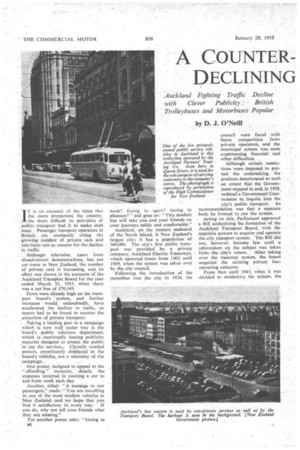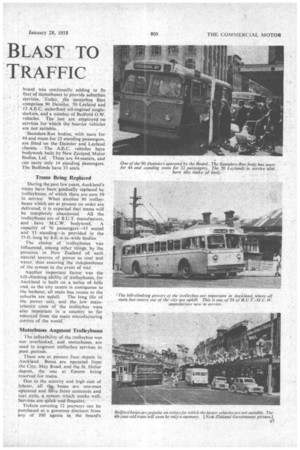A COUNTER DECLINING BLAST TO TRAFFIC
Page 32

Page 33

Page 34

If you've noticed an error in this article please click here to report it so we can fix it.
Auckland Fighting Traffic Decline with Clever Publicity : British Trolleybuses and Motorbuses Popular by D. J. O'Neill
IT is an anomaly of the times that the more prosperous the country. the more difficult its providers of public transport find it to make ends meet. Passenger transport operators in Britain are constantly citing the growing number of private cars and television sets as reasons for the decline in traffic. . . Although television, apart from dosed-circuit demonstrations, has not yet come to New Zealand, the number of private cars is increasing, and, its effect was shown in the accounts of'the Auckland Transport Board for the year ended March 31, 1953, when there was a net loss of £70,149.
Fares were already high on the transport board's system, and further increases would, undoubtedly, have accelerated the decline in traffic, so means had to be found to counter the attraction of private transport.
.Taking a leading part in a campaign which is now well under way is the board's public relations department, which is continually issuing publicity material designed to attract the public to use the services. Cleverly worded
, posteis, prominently dis-played in the board's vehicles, are a mainstay of -the
campaign. .
• One poster., designed to appeal to the " offending " motorist, details theexpenses incurred in running a car to and from work each day.
Another, titled: " A message to our passengers," reads: "You are travelling . in one of the most modern vehicles in New Zealand,--and we hope that you find it satisfactory in every way. If you do, why not tell your friends what they are missing."
Yet another poster asks: "Going to B6 work? Going to sport? Going to pleasure? " and goes on: " This modern bus will take you and your friends on your journeys safely and comfortably."
Auckland, on the western seaboard of the North Island, is New Zealand's largest city; it has a population of 360,000. The city's first public transport was provided by a private company, Auckland Electric Tramways, which operated trams from 1902 until 1919, when the system was taken over by the city council.
Following the introduction of the motorbus into the city in 1924, the council were faced with fierce competition from private operators, and the municipal system was soon experiencing financial • and other difficulties. .
Although certain restrictions were imposed to protect the undertaking, the position deteriorated to such an extent that the Government stepped in and, in 1928, ordered a Government Cornmission to. inquire into the city's public transport. Its recommendation was that a separate body be formed to run the system.
Acting on this, Parliament approved a .Bill authorizing the formation of the Auckland Transport Board, with the requisite powers to acquire and operate the city transport system. The Bill did not, however, become law until a referendum oq the subject was taken from the city's voters. After taking over the tramway system, the board acquired the existing private busoperating concerns.
From then until 1943, when it was decided to modernize the system, the
hoard was continually adding to its fleet of motorbuses to provide suburban services. -Today, the Motorbus fleet comprises 90 Daimler, 50 Leyland and 13 A.E.C. underfloOk oil-engined Singledeckers, and a number of Bedford O.W. vehicles. The last arc. employed on services for Which the heavier vehicles are not suitable.
Saunders-Roe bodies, with seats for 44 and room for 22 standing passengers, are fitted on the Daimler and Leyland chassis. The A.E.C. vehicles have bodywork built by New -Zealand Motor Bodies, Ltd. These are 44-seaters, and can carry only 14 standing Passengers. The Bedfords have 33 seats.
Trams Being Replaced During the past few years, Auckland's trams have been gradually replaced by trolleybuses, of which there are now 59 in service. When another 40 trolleybuses which are at present on order are delivered, it is expectedthat trams will be completely abandoned. All the trolleybuses are of B.U.T. manufacture, and have M.C.W. bodywork. A capacity of 76 passengers-43 seated and 33 standing—is provided in the• 35-ft-long by 8-ft.-6-in.-wide bodies.
The choice of trolleybuses was influenced, among other things, by the presence in New Zealand of such natural sources of power as coal and water, thus ensuring the independence of the system in the event of wat.
Another important factor was the hill-climbing ability of trolleybuses, for Auckland is built on a series of hills and, as the city centre is contiguous to the harbour, all main bus routes to the suburbs are uphill. The long life of the Power unit, and the low Maintenance costs of the trolleybus were also important in a country so far removed from the main manufacturing centres of the world.
Motorbuses Augment Trolleybuses
The inflexibility of the trolleybus was notoverlooked, and motorbuses are used to augment trolleybus services in peak periods.
There are at present four depots in Auckland. Buses are operated from the City,• May Road, and the St. Helier depots, the one at Epsom being reserved for trams.
Due to the scarcity and high cost of labour, all tbk buses are one-man operated and have front entrances and rear exits, a system which works well. Services are qiiick and frequent.
Tickets covering 12 journeys can be purchased at a generous discount from any of 100 agents in the board's operating area. Season and annual tickets are also available from the same source.
During peak periods, tickets for a specific journey can be bought at busy loading points, thereby ensuring the minimum delay to services. At these times, multiple-journey tickets are also inspected and punched before the holders board the buses.
"Fares-owing forms" are carried on every vehicle. These are completed by the driver in respect of a passenger who is unable to pay his fare at the time of a journey.
Vehicle maintenance is of a high standard. A unit exchange plan is in operation, the depots drawing reconditioned units from the board's wellequipped workshops in Manukau Road, where the bodybuilding and paint shops are also situated.
The chief difficulty facing the board on the maintenance side is the time lag in securing from a manufacturer a replacement for a major unit in dis
repair. Replacements for many smaller parts are usually readily available locally. An attraction of the Saunders-Roe and M.C.W. bodies, which are reported to be very satisfactory, is that they are easy to repair, and a stock is kept of body replacement parts.
The Bedfords are popular, and as they become due for replacement are being superseded by current models, of the same make powered by the 100 b.h.p. petrol efigine.




















































































